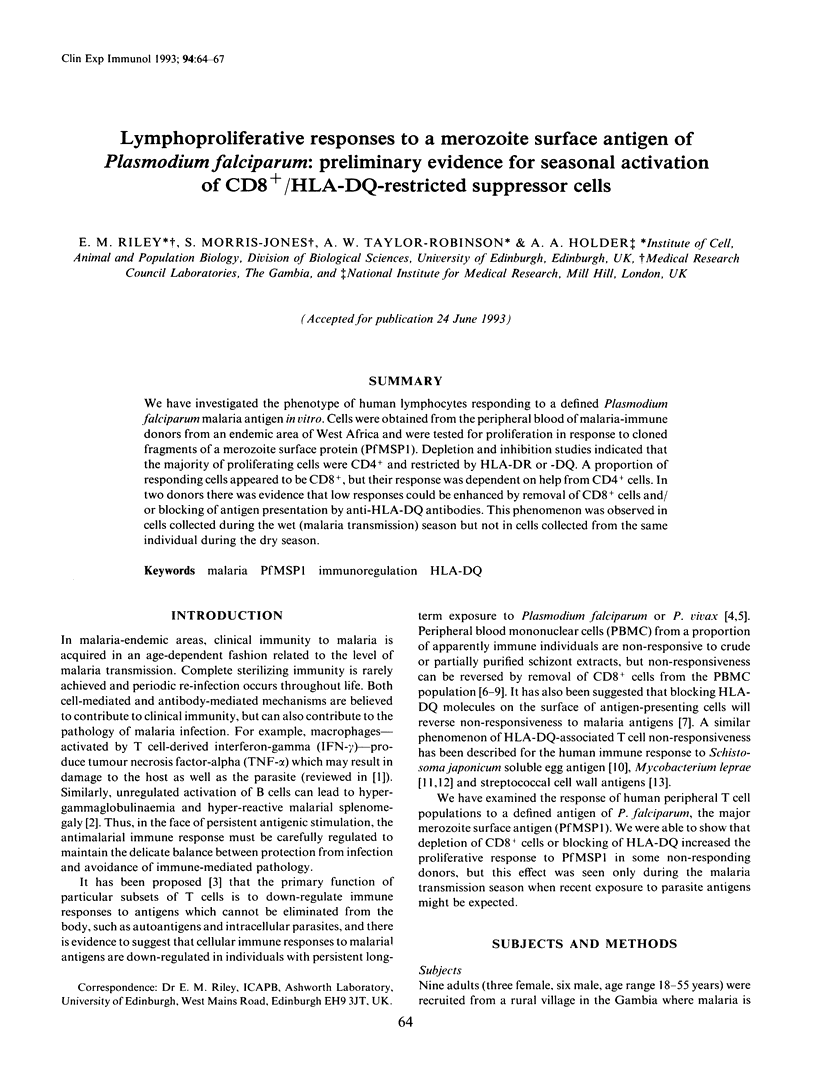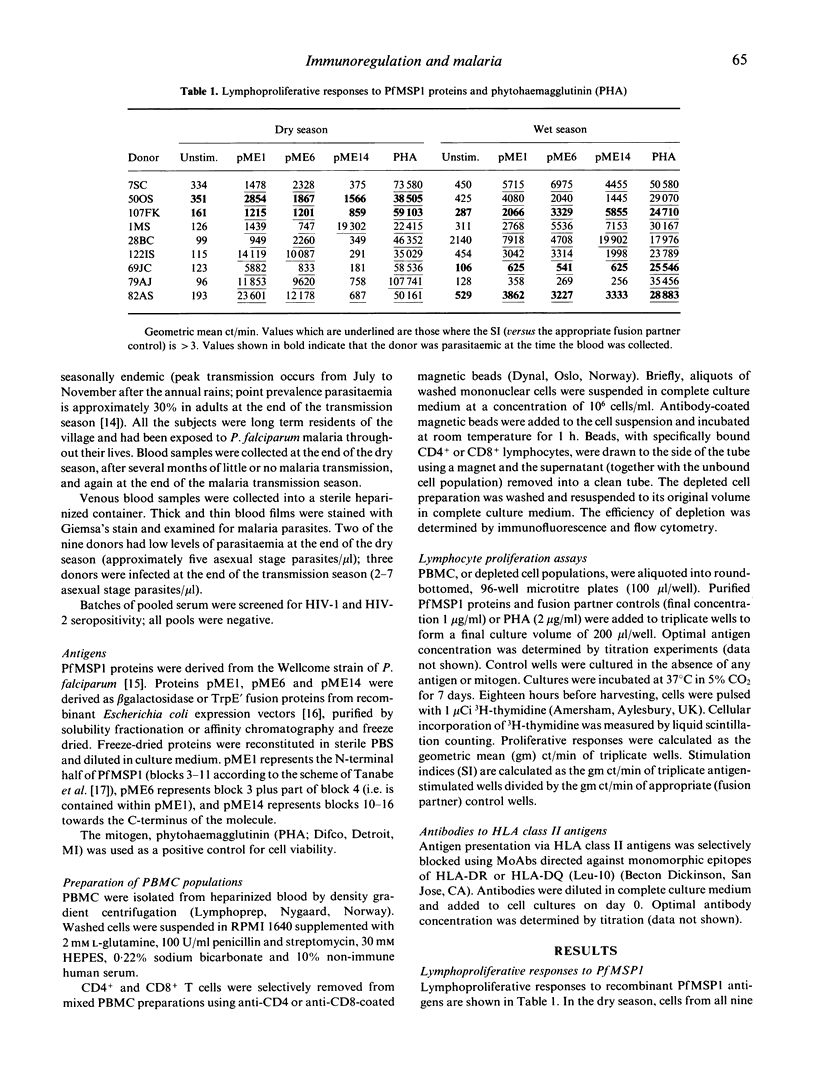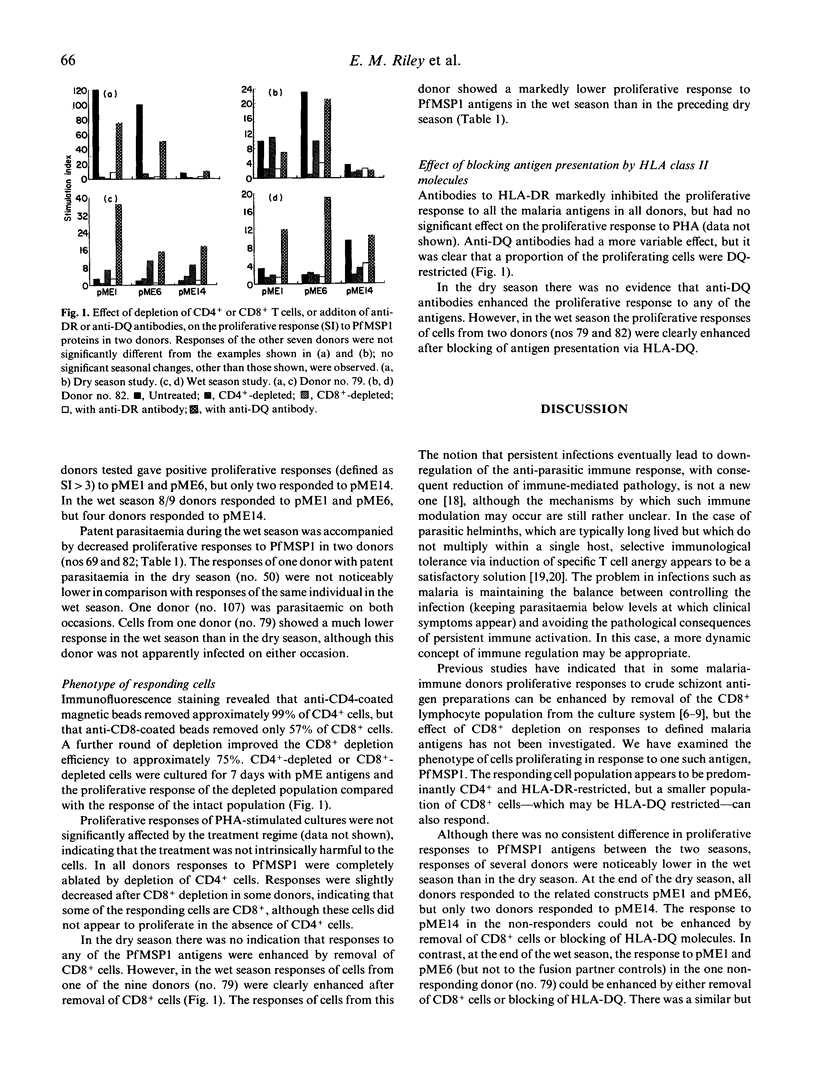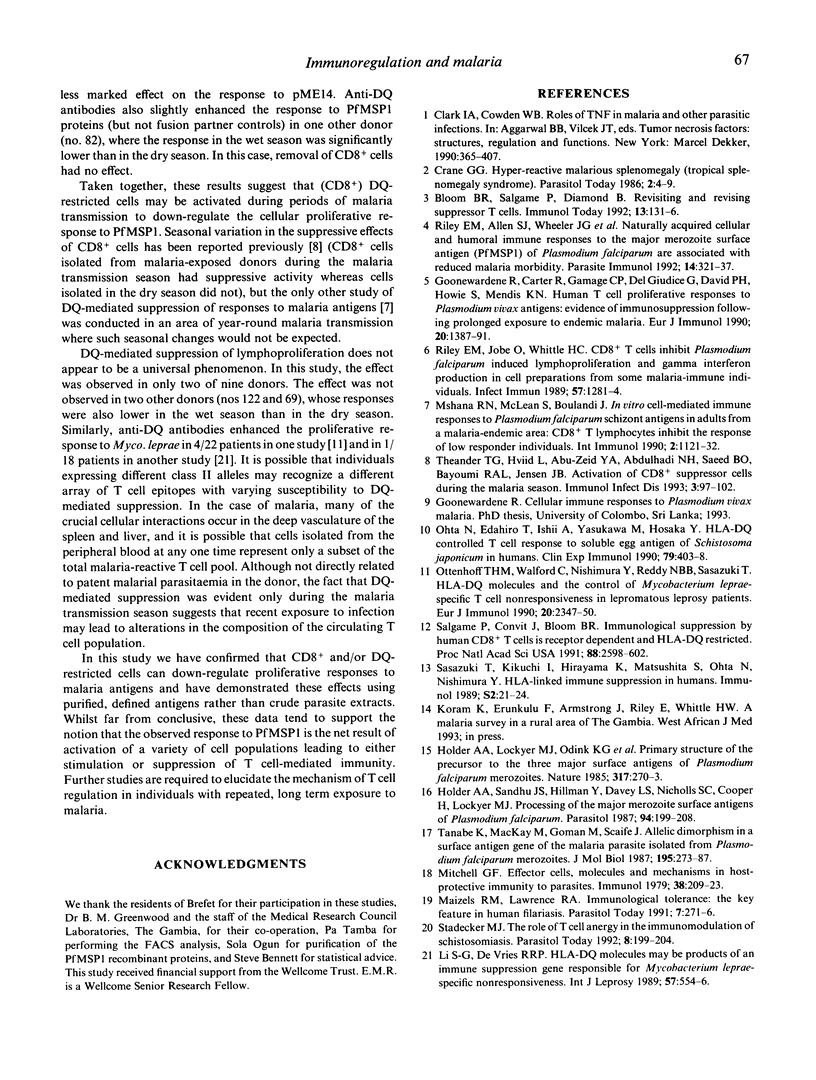Abstract
We have investigated the phenotype of human lymphocytes responding to a defined Plasmodium falciparum malaria antigen in vitro. Cells were obtained from the peripheral blood of malaria-immune donors from an endemic area of West Africa and were tested for proliferation in response to cloned fragments of a merozoite surface protein (PfMSP1). Depletion and inhibition studies indicated that the majority of proliferating cells were CD4+ and restricted by HLA-DR or -DQ. A proportion of responding cells appeared to be CD8+, but their response was dependent on help from CD4+ cells. In two donors there was evidence that low responses could be enhanced by removal of CD8+ cells and/or blocking of antigen presentation by anti-HLA-DQ antibodies. This phenomenon was observed in cells collected during the wet (malaria transmission) season but not in cells collected from the same individual during the dry season.
Full text
PDF



Selected References
These references are in PubMed. This may not be the complete list of references from this article.
- Bloom B. R., Salgame P., Diamond B. Revisiting and revising suppressor T cells. Immunol Today. 1992 Apr;13(4):131–136. doi: 10.1016/0167-5699(92)90110-S. [DOI] [PubMed] [Google Scholar]
- Crane G. G. Hyperreactive malarious splenomegaly (tropical splenomegaly syndrome). Parasitol Today. 1986 Jan;2(1):4–9. doi: 10.1016/0169-4758(86)90067-0. [DOI] [PubMed] [Google Scholar]
- Goonewardene R., Carter R., Gamage C. P., Del Giudice G., David P. H., Howie S., Mendis K. N. Human T cell proliferative responses to Plasmodium vivax antigens: evidence of immunosuppression following prolonged exposure to endemic malaria. Eur J Immunol. 1990 Jun;20(6):1387–1391. doi: 10.1002/eji.1830200626. [DOI] [PubMed] [Google Scholar]
- Holder A. A., Lockyer M. J., Odink K. G., Sandhu J. S., Riveros-Moreno V., Nicholls S. C., Hillman Y., Davey L. S., Tizard M. L., Schwarz R. T. Primary structure of the precursor to the three major surface antigens of Plasmodium falciparum merozoites. Nature. 1985 Sep 19;317(6034):270–273. doi: 10.1038/317270a0. [DOI] [PubMed] [Google Scholar]
- Holder A. A., Sandhu J. S., Hillman Y., Davey L. S., Nicholls S. C., Cooper H., Lockyer M. J. Processing of the precursor to the major merozoite surface antigens of Plasmodium falciparum. Parasitology. 1987 Apr;94(Pt 2):199–208. doi: 10.1017/s0031182000053889. [DOI] [PubMed] [Google Scholar]
- Li S. G., de Vries R. R. HLA-DQ molecules may be products of an immune suppression gene responsible for Mycobacterium leprae-specific nonresponsiveness. Int J Lepr Other Mycobact Dis. 1989 Jun;57(2):554–556. [PubMed] [Google Scholar]
- Maizels R. M., Lawrence R. A. Immunological tolerance: The key feature in human filariasis? Parasitol Today. 1991 Oct;7(10):271–276. doi: 10.1016/0169-4758(91)90093-4. [DOI] [PubMed] [Google Scholar]
- Mitchell G. F. Effector cells, molecules and mechanisms in host-protective immunity to parasites. Immunology. 1979 Oct;38(2):209–223. [PMC free article] [PubMed] [Google Scholar]
- Mshana R. N., McLean S., Boulandi J. In vitro cell-mediated immune responses to Plasmodium falciparum schizont antigens in adults from a malaria endemic area: CD8+ T lymphocytes inhibit the response of low responder individuals. Int Immunol. 1990;2(12):1121–1132. doi: 10.1093/intimm/2.12.1121. [DOI] [PubMed] [Google Scholar]
- Ohta N., Edahiro T., Ishii A., Yasukawa M., Hosaka Y. HLA-DQ-controlled T cell response to soluble egg antigen of Schistosoma japonicum in humans. Clin Exp Immunol. 1990 Mar;79(3):403–408. doi: 10.1111/j.1365-2249.1990.tb08103.x. [DOI] [PMC free article] [PubMed] [Google Scholar]
- Ottenhoff T. H., Walford C., Nishimura Y., Reddy N. B., Sasazuki T. HLA-DQ molecules and the control of Mycobacterium leprae-specific T cell nonresponsiveness in lepromatous leprosy patients. Eur J Immunol. 1990 Oct;20(10):2347–2350. doi: 10.1002/eji.1830201027. [DOI] [PubMed] [Google Scholar]
- Riley E. M., Allen S. J., Wheeler J. G., Blackman M. J., Bennett S., Takacs B., Schönfeld H. J., Holder A. A., Greenwood B. M. Naturally acquired cellular and humoral immune responses to the major merozoite surface antigen (PfMSP1) of Plasmodium falciparum are associated with reduced malaria morbidity. Parasite Immunol. 1992 May;14(3):321–337. doi: 10.1111/j.1365-3024.1992.tb00471.x. [DOI] [PubMed] [Google Scholar]
- Riley E. M., Jobe O., Whittle H. C. CD8+ T cells inhibit Plasmodium falciparum-induced lymphoproliferation and gamma interferon production in cell preparations from some malaria-immune individuals. Infect Immun. 1989 Apr;57(4):1281–1284. doi: 10.1128/iai.57.4.1281-1284.1989. [DOI] [PMC free article] [PubMed] [Google Scholar]
- Salgame P., Convit J., Bloom B. R. Immunological suppression by human CD8+ T cells is receptor dependent and HLA-DQ restricted. Proc Natl Acad Sci U S A. 1991 Mar 15;88(6):2598–2602. doi: 10.1073/pnas.88.6.2598. [DOI] [PMC free article] [PubMed] [Google Scholar]
- Sasazuki T., Kikuchi I., Hirayama K., Matsushita S., Ohta N., Nishimura Y. HLA-linked immune suppression in humans. Immunol Suppl. 1989;2:21–25. [PubMed] [Google Scholar]
- Stadecker M. J. The role of T-cell anergy in the immunomodulation of schistosomiasis. Parasitol Today. 1992 Jun;8(6):199–204. doi: 10.1016/0169-4758(92)90264-3. [DOI] [PubMed] [Google Scholar]
- Tanabe K., Mackay M., Goman M., Scaife J. G. Allelic dimorphism in a surface antigen gene of the malaria parasite Plasmodium falciparum. J Mol Biol. 1987 May 20;195(2):273–287. doi: 10.1016/0022-2836(87)90649-8. [DOI] [PubMed] [Google Scholar]


